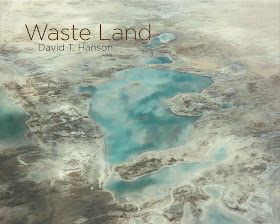In 1980 more than 400,000 toxic waste sites overspread the United States, I learn from this book. Moreover: “The Environmental Protection Agency (EPA) declared 400 of these highly hazardous and in need of immediate attention. In just a few years, the numbers of these ‘Superfund’ sites more than tripled.” Not many have seen them and most are unaware of them. Needless to say, it shouldn’t be like that. And so photographer David T. Hanson did what a photographer is able to do in order to put things right – make these sites seen.
Over the course of a year, beginning in 1985, he traveled to 45 states on a Guggenheim Fellowship to make aerial photographs of 67 such sites. The photographs of these dangerously polluted places can be seen in this tome, each juxtaposed with a modified topographic map and the EPA’s own description of the site’s history and Hazards.
I particularly warmed to the (very brief and very angry) foreword by Wendell Berry that starts like this: “It is unfortunately supposable that some people will account for these photographic images as ‘abstract art,’ or will see them as ‘beautiful shapes.’ But anybody who troubles to identify in these pictures the things that are readily identifiable (trees, buildings, roads, vehicles, etc.) will see that nothing in them is abstract and that their common subject is a monstrous ugliness.” In other words: Don’t be swayed by your first impulse, think, reflect, have a closer look, ask questions such as ‘what do my eyes show me?’, ‘what does the photographer want me to focus on, and to think about?
.
To confront reality is something human beings generally shy away from, and especially when this reality is unpleasent, ugly and man-made. Yet we need to look at it. And we need to ask questions, hard questions. Is this really how we want to treat the environment on which our survival depends?
.
To confront reality is something human beings generally shy away from, and especially when this reality is unpleasent, ugly and man-made. Yet we need to look at it. And we need to ask questions, hard questions. Is this really how we want to treat the environment on which our survival depends?
For the full review, see here














